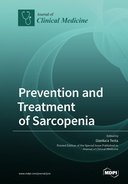Explore

Prevention and Treatment of Sarcopenia
0 Ungluers have
Faved this Work
Login to Fave
Sarcopenia represents the decline in skeletal muscle mass and function with age, characterized by the muscle fiber's quality, strength, muscle endurance, and metabolic ability decreasing, as well as the fat and connective tissue growing.Reduction of muscle strength with aging leads to loss of functional capacity, causing disability, mortality, and other adverse health outcomes. Because of the increase of the proportion of elderly in the population, sarcopenia-related morbidity will become an increasing area of health care resource utilization.Diagnostic screening consists of individuation of body composition, assessed by DEXA, anthropometry, bioelectrical impedance, MRI, or CT scan. Management is possible with resistance training exercise and vibration therapy, nutritional supplements, and pharmacological treatment.The book includes articles from different nationalities, treating the experimental and medical applications of sarcopenia. The consequences of sarcopenia in frailty are treated in relation to other associated pathologies or lesions, as femoral neck fractures and hepatocellular carcinoma.
This book is included in DOAB.
Why read this book? Have your say.
You must be logged in to comment.
Rights Information
Are you the author or publisher of this work? If so, you can claim it as yours by registering as an Unglue.it rights holder.Downloads
This work has been downloaded 88 times via unglue.it ebook links.
- 88 - pdf (CC BY) at Unglue.it.
Keywords
- accelerometer
- aerobic exercise training
- Aged
- ageing fractures
- Aging
- Anxiety
- Apoptosis
- balance
- bisphosphonate
- brain-body cross-talk
- clinical
- Cognition
- Complications
- deconditioning
- decorin
- Depression
- Diagnosis
- diagnostic criteria
- dual-energy X-ray absorptiometry
- echogenicity
- elderly
- electrical stimulation
- endurance
- epidemiologic studies
- Exercise
- exercise intervention
- fall risk
- falls
- Fatigue
- Fractures
- Frailty
- hepatoma
- Hip Fracture
- hospitalized older patients
- Hypertrophy
- insomnia
- isokinetic dynamometry
- Lipids
- medicine
- Mitochondria
- Motivation
- multimorbidity
- muscle mass
- muscle quality
- muscle regulatory factors
- Muscle strength
- muscle-mass
- myokine
- nutritional screening tools
- nutritional status
- nutritional supplements
- older adults
- older persons
- osteoporosis
- Oxidative Stress
- panoramic ultrasound
- physical activity
- physical functional performance
- Physical Therapy
- polypathological patients
- postmenopausal women
- Prevalence
- Prevention
- protein intake
- Quality of life
- randomized controlled trial
- Recovery
- Rehabilitation
- resistance exercise
- resistance exercise training
- resistance training
- respiratory system
- Sarcopenia
- sedentary behaviour
- skeletal muscle
- skeletal muscles
- sleep duration
- sleep efficiency
- sleep quality
- specific force
- spirometry
- strength
- Survival
- telomere length
- transaminases
- Treatment
- type 2 diabetes
- urea
- Vibration
- walking distance
- β-hydroxy-β-methylbutyrate
Links
DOI: 10.3390/books978-3-0365-1535-9Editions

